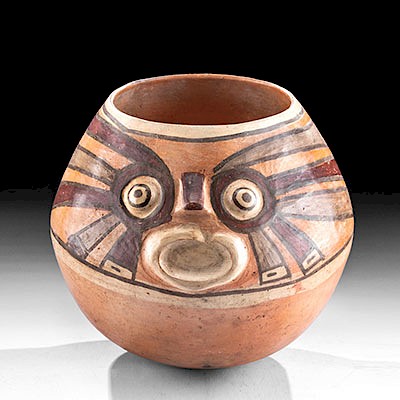12th C. Afghanistan Pottery Jar w/ Woman, TL Tested
Lot 60d
About Seller
Artemis Fine Arts
686 S Taylor Ave, Ste 106
Louisville, CO 80027
United States
Selling antiquities, ancient and ethnographic art online since 1993, Artemis Gallery specializes in Classical Antiquities (Egyptian, Greek, Roman, Near Eastern), Asian, Pre-Columbian, African / Tribal / Oceanographic art. Our extensive inventory includes pottery, stone, metal, wood, glass and textil...Read more
Categories
Estimate:
$4,000 - $6,000
Absentee vs Live bid
Two ways to bid:
- Leave a max absentee bid and the platform will bid on your behalf up to your maximum bid during the live auction.
- Bid live during the auction and your bids will be submitted real-time to the auctioneer.
Bid Increments
| Price | Bid Increment |
|---|---|
| $0 | $25 |
| $300 | $50 |
| $1,000 | $100 |
| $2,000 | $250 |
| $5,000 | $500 |
| $10,000 | $1,000 |
| $20,000 | $2,500 |
| $50,000 | $5,000 |
| $100,000 | $10,000 |
| $200,000 | $20,000 |
About Auction
By Artemis Fine Arts
Dec 5, 2019
Set Reminder
2019-12-05 10:00:00
2019-12-05 10:00:00
America/New_York
Bidsquare
Bidsquare : Ancient / Ethnographic - Holiday Edition
https://www.bidsquare.com/auctions/artemis-gallery/ancient-ethnographic---holiday-edition-4710
What to give this holiday season? Ancient & Ethnographic Art of course! Our special Holiday auction features hundreds of unique finds from all over the world. Artemis Fine Arts info@artemisfinearts.com
What to give this holiday season? Ancient & Ethnographic Art of course! Our special Holiday auction features hundreds of unique finds from all over the world. Artemis Fine Arts info@artemisfinearts.com
- Lot Description
Central Asia, central Afghanistan, Jam in Ghur province, Ghurid Dynasty, ca. 12th to 13th century CE. A charming ceramic vessel with a bulbous lower body, flattened base, and an abstract representation of a woman's head applied to its flared, conical neck, in a rare style known as "Monar e Jam". The head is triangular, with a pronounced chin and nearly flat forehead. Ornaments in the form of applied hair, earrings, headdress, and multiple necklaces combine with a profusion of painted red-on-cream motifs to create an impression of a woman dressed richly. Her arms and hands are applied to the sides of the vessel, so that she appears to be holding her breasts on the vessel's shoulder. The diminutive loop handle on the shoulder behind the woman completes this charming piece. Size: 6" W x 8.2" H (15.2 cm x 20.8 cm)
Who is the woman represented? Little is known about the Ghurid Dynasty so all we can do is speculate on who might have been depicted on their vessels - an elite figure such as Malika-e-Khurasani, a politician and princess; a beloved daughter such as Hara Jalai, the daughter of the Sultan Ghyasuddin, or even an abstract figure like a goddess or generic woman? Afghanistan has had little modern archaeological research and as a result its history remains sadly unexplored - for example, most of the knowledge about the country's medieval ceramics is from the 1950s and 1960s. However, the it clearly has a rich heritage. The area today known as Jam was once Firuzkuh, the summer capital of the Ghurid sultanate, destroyed by the Mongols around 1222-1223 CE and rediscovered by international researchers because of its huge minaret in 1957. A wide profusion of different style vessels seem to have been made in medieval Jam during the short Ghurid Dynasty, which enjoyed brief success in the 12th century before collapsing after the death of its most charismatic rulers; indeed, when the Mongols destroyed it, it seems to have already been a city in decline. The pottery made there is all the more remarkable for the brief window in which it was made.
This piece has been tested using thermoluminescence (TL) analysis and has been found to be ancient and of the period stated. A full report will accompany purchase.
Provenance: private California, USA collection, moved from Germany in 1997
All items legal to buy/sell under U.S. Statute covering cultural patrimony Code 2600, CHAPTER 14, and are guaranteed to be as described or your money back.
A Certificate of Authenticity will accompany all winning bids.
We ship worldwide and handle all shipping in-house for your convenience.
#148835Possible small area of repair on back of neck; otherwise in great condition with nice deposits on surface and great deposits.Condition
- Shipping Info
-
All shipping is handled in-house for your convenience. Your invoice from Artemis Gallery will include shipping calculation instructions. If in doubt, please inquire BEFORE bidding for estimated shipping costs for individual items.
-
- Buyer's Premium



 EUR
EUR CAD
CAD AUD
AUD GBP
GBP MXN
MXN HKD
HKD CNY
CNY MYR
MYR SEK
SEK SGD
SGD CHF
CHF THB
THB
















